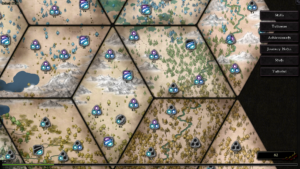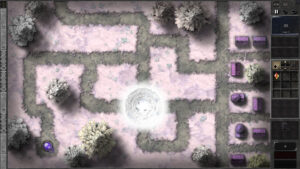Frostborn Wrath: Field Tokens
I’ve mentioned “field tokens” a few times, so let me explain what I mean. In every Gemcraft game except Labyrinth, battlefields are shown on the map as a sort of frame-like icon, usually in the same bulging triangle shape as a grade 1 gem. Gemcraft Chapter 0: Gem of Eternity, the second game, additionally used this frame to keep track of which play modes you had completed the field in, dividing it into segments and illuminating the ones completed. Chasing Shadows turned these indicators into glowing gems held within holes in the frame. But it also presented it as a literal token, a trinket that could be found in a locked chest or otherwise handed to you as part of your rewards on completing a level. How exactly a physical object grants you access to battlefields was left unexplained.
Chasing Shadows had four shapes of field tokens. You had your standard triangular ones with a circular gem slot at each corner, for normal fields. Vision fields had their special circular tokens with only one slot, shaped like flames. Then there were trangular ones with a sort of spiral pattern to the slots, indicating a field with a Tome Chamber that teaches a new skill, and square ones with stripes, for Wizard Towers where you have to unlock certain mechanisms before the last monster wave to win and unlock other benefits. (Usually adding more waves makes a field harder to beat, but in Wizard Tower fields, it buys you more time to destroy the locks.) I don’t think these meanings were ever explained explicitly, but it was an easy pattern to notice.
 Frostborn Wrath, now. Frostborn Wrath uses the three token shapes from Chasing Shadows (excluding the one for Vision fields), as well as a couple entirely new ones. But it doesn’t have Tome Chambers or Wizard Towers. Their function as dispensers of unlockables is taken by locked chests, but locked chests aren’t indicated by the shape of the token; there are plenty of locked chests in fields with just the base token. What does the shape indicate, then? I have no idea. Maybe they’re just assigned haphazardly, but I’m not quite willing to believe that. Maybe even without Tome Chambers, there’s a token shape that indicates a field where you can obtain a new skill — but if so, the connection is a lot harder to notice than it was in CS, where skills were always linked to permanent environmental features. There’s probably a lesson in that.
Frostborn Wrath, now. Frostborn Wrath uses the three token shapes from Chasing Shadows (excluding the one for Vision fields), as well as a couple entirely new ones. But it doesn’t have Tome Chambers or Wizard Towers. Their function as dispensers of unlockables is taken by locked chests, but locked chests aren’t indicated by the shape of the token; there are plenty of locked chests in fields with just the base token. What does the shape indicate, then? I have no idea. Maybe they’re just assigned haphazardly, but I’m not quite willing to believe that. Maybe even without Tome Chambers, there’s a token shape that indicates a field where you can obtain a new skill — but if so, the connection is a lot harder to notice than it was in CS, where skills were always linked to permanent environmental features. There’s probably a lesson in that.
 Comments(0)
Comments(0)